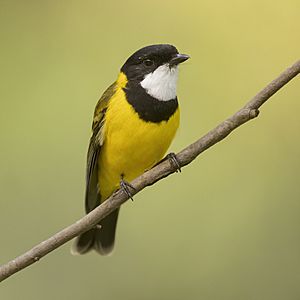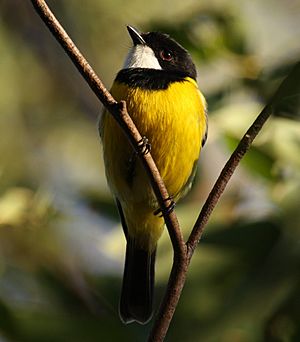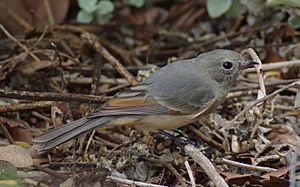Australian golden whistler facts for kids
Quick facts for kids Australian golden whistler |
|
|---|---|
 |
|
| Male | |
 |
|
| Female, Queensland, Australia | |
| Conservation status | |
| Scientific classification | |
| Genus: |
Pachycephala
|
| Species: |
pectoralis
|
| Subspecies | |
|
See text |
|
| Synonyms | |
|
|
The Australian golden whistler (Pachycephala pectoralis) is a beautiful bird found in many parts of Australia. You can spot it in forests, woodlands, and even near the coast in mangroves. Most of these birds stay in one place all year, but some from south-eastern Australia fly north for the winter.
Scientists find the way golden whistlers are grouped into different types (called taxonomy) quite tricky. Some think there are many different kinds of golden whistlers, while others believe some of these should be seen as their own separate species.
Contents
About the Golden Whistler
The Australian golden whistler was first described by an English bird expert named John Latham in 1801. He first put it in a different bird group called Muscicapa.
Different Types of Golden Whistlers
The golden whistler family is a bit complicated for scientists. There are many different types, or subspecies, of golden whistlers, and they can look quite different from each other. These different types live in places like Indonesia, Papua New Guinea, and other islands.
Today, scientists usually recognize six main subspecies of the Australian golden whistler:
- P. p. pectoralis - This type lives in eastern Australia.
- Norfolk golden whistler (P. p. xanthoprocta) - You can find this one on Norfolk Island, which is part of Australia.
- Lord Howe golden whistler (P. p. contempta) - This type lives on Lord Howe Island, also part of Australia.
- P. p. youngi - Found in south-eastern Australia.
- P. p. glaucura - This one lives in Tasmania and the nearby Bass Strait Islands.
- P. p. fuliginosa - You can find this type in south-central Australia.
What They Look Like

Male golden whistlers are very colorful! They have a bright yellow belly and neck, with an olive-green back and wings. Their head is black, and they have a black band across their chest. Their throat is white. However, the Norfolk golden whistler male looks more like the female, which is unusual.
Female golden whistlers in Australia are usually dull brownish-grey. Some might have a bit of yellow under their tail. Both male and female birds have a black beak, dark legs, and reddish-brown eyes.
These birds are known for their strong, musical songs.
Where They Live and What They Eat
You can find the Australian golden whistler in almost any place with trees, especially thick forests. They love to eat berries, insects, spiders, and other small creatures with many legs, called arthropods.
They usually look for food by themselves. They search for food from the lower branches to the middle parts of trees. Sometimes, they join groups of different bird species to find food together.
How They Live
Australian golden whistlers build their nests and raise their young between September and January. Both the male and female birds help build the nest. It's a shallow, cup-shaped nest made from small branches, grass, and tree bark, all held together with spider web.
They usually raise only one group of babies each season. Both parents take turns sitting on the eggs to keep them warm (this is called incubation) and caring for the young birds. The eggs hatch about 15 days after they are laid. The young birds are ready to leave the nest when they are about 12 days old.
Their Status
The Australian golden whistler is considered a species of least concern. This means there are plenty of them, and they are generally common.
However, some types, like the Norfolk golden whistler (P. p. xanthoprocta), have had a harder time. Their numbers went down for many years because their homes (habitats) were destroyed or broken up. Also, new animals brought to the island, like black rats, might have eaten their eggs or young. Most of these birds now live in the Norfolk Island National Park. Because of this, the Australian Government once listed them as vulnerable, meaning they needed special protection.
Another island type, the Lord Howe golden whistler (P. p. contempta), is still common. It was also once listed as vulnerable by the Australian Government because it lives in a very small area. However, it is not listed as vulnerable anymore.
See also
 In Spanish: Silbador dorado para niños
In Spanish: Silbador dorado para niños



